Copperheads are among the most common venomous snakes that people encounter in the southeastern United States. These reptiles are often killed, but they probably don’t deserve it. Today, we are going to take a look at copperhead snakes in Alabama and discover how often they actually bite people.
Let’s discover the copperheads in Alabama, where they live, and how often they bite. By the end, you may just learn something new about these amazing snakes!
Do copperheads live in Alabama?
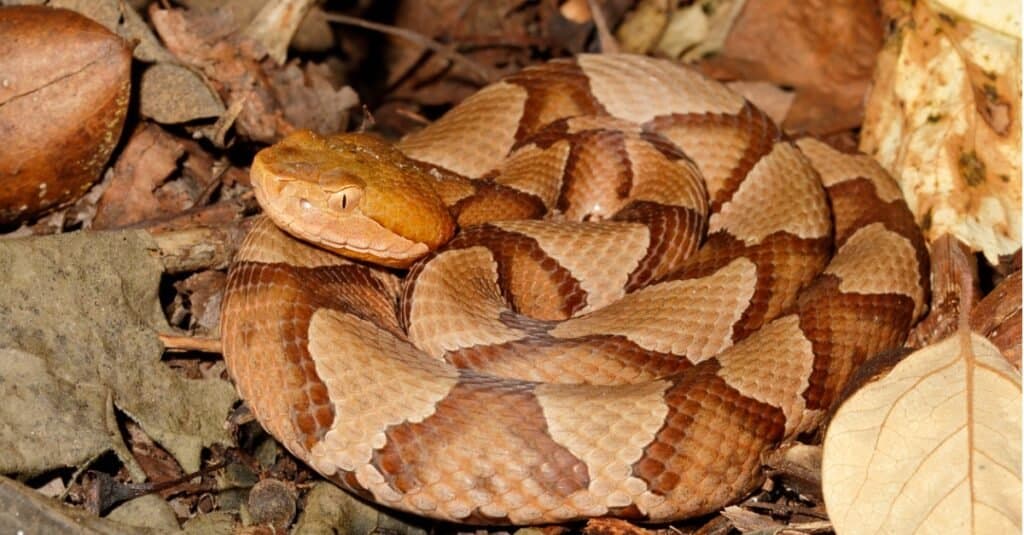
The copperhead is a venomous snake that lives in the southeast, including Alabama.
©iStock.com/David Kenny
Copperheads can be found across Alabama, with two subspecies living in the state.
Although venomous snakes are quite scary to many people, they are much more common than we would think and rarely bother people. The copperhead is a member of the pit viper family, along with rattlesnakes and cottonmouths. Between the three groups of snakes, copperheads are generally considered the least dangerous. Most copperheads are smaller than rattlesnakes and cottonmouths, although it isn’t always the case.
Pit vipers can be identified by the small pits located between their eyes and nose. These pits are used to sense heat in order to track and prey on warm-blooded animals. Although copperheads, like all pit vipers, are venomous, they aren’t considered highly dangerous, and fatal bites are extremely rare. Additionally, copperheads would much prefer to rely on their camouflage and avoid humans entirely. Most instances of attacks are from unaware humans reaching into the brush where a scared and defensive snake is waiting.
Identifying the subspecies of copperheads in Alabama
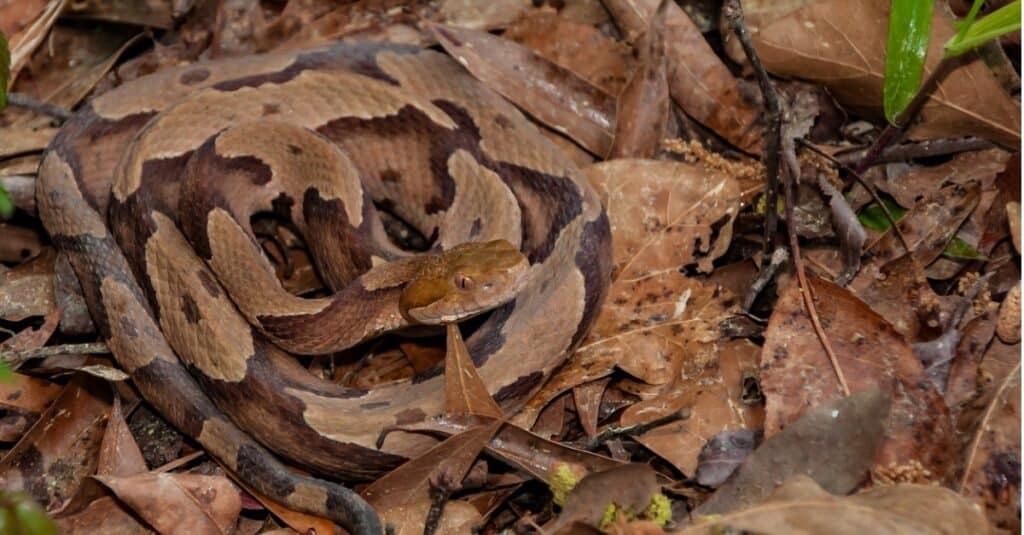
There are two subspecies of copperhead in Alabama, but they both look incredibly similar.
©iStock.com/JasonOndreicka
There are three primary subspecies of copperhead that live across the eastern United States. Alabama is home to two of these species. Although they are quite similar, they have different ranges and slightly different colorations. Here are a few things that all species of copperheads have:
- heat-sensing pits between their nose and eyes on either side of the face.
- brown, tan, and copper colors, although the exact pattern can be different from snake to snake.
- cat-like eyes that are usually golden or yellow. Eyes usually have a thick eyebrow scale that gives a distinct “mean” look.
Northern copperhead
Identification: Northern copperheads are light brown or tan, giving them the “copper” part of their name. One of the best ways to tell a copperhead is the presence of dark bands that begin at the head and travel down the body. These bands are wider at the sides and narrower near the spine, forming an hourglass-like shape. For northern copperheads, these bands are especially wide around the sides, and there are usually spots on their back between the bands. Northern copperheads are usually more reddish than southern copperheads.
Distribution: Northern copperheads can be found along the Alabama-Tennessee border in the north, down towards the Tennessee River. They are occasionally found below the Tennessee River.
Southern copperhead
Identification: The southern copperhead also comes in shades of brown, tan, and copper. When comparing the striping pattern to the northern copperhead, the southern’s stripes are usually thinner and tighter. Additionally, the space between them has little to no spots compared to the northern species. Most southern copperheads are paler in color, with many describing them as having a pinkish hue.
Distribution: The southern copperhead can be found across the southern regions of the state, primarily in the Lower Coastal Plains region. It’s also important to note that the two species interbreed and often share territory.
How often are people bitten by copperheads in Alabama?
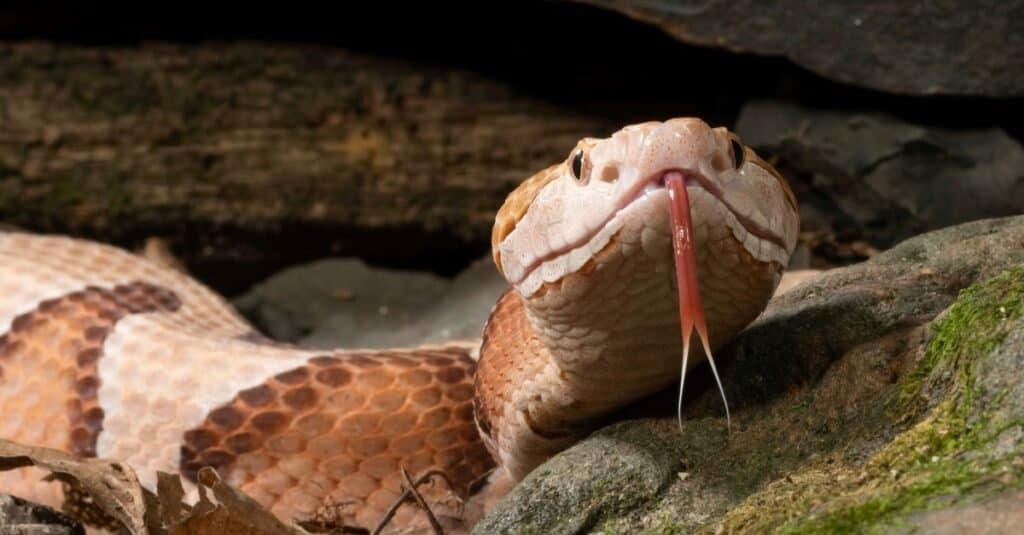
Copperhead bites are rare in Alabama. Fatal bites are even rarer.
©Joe McDonald/Shutterstock.com
Although copperheads are venomous, they are quite reticent to bite. When the snake is visible and both parties are aware of the other, bites rarely happen. Most copperhead bites happen when a human accidentally steps on one or reaches into the territory of one without knowing. The snake will then strike as the human is a perceived threat.
When bites happen, the resulting danger is usually very low. Of all the venomous snakes in North America, the copperhead is usually regarded as the least dangerous. When bitten, the local area tends to swell, and tissue necrosis is common. The venom of the copperhead is adapted to attack blood and muscle tissue.
There are about 2,290 people bitten by copperheads each year. Within that number, the fatality rate is less than 0.01%. The majority of deaths associated with copperheads are due to an allergy to the venom rather than the power of the venom itself. Snake venom can sometimes trigger allergies in individuals similar to a bee allergy. A single person dies from snake bites in Alabama every ten years, so panic isn’t needed when encountering these snakes.
Snakes commonly mistaken for copperheads in Alabama
There are a few snakes in Alabama that are sometimes mistaken for copperheads, mostly due to their appearance. Let’s take a look at a few of the most common.
Timber rattlesnake
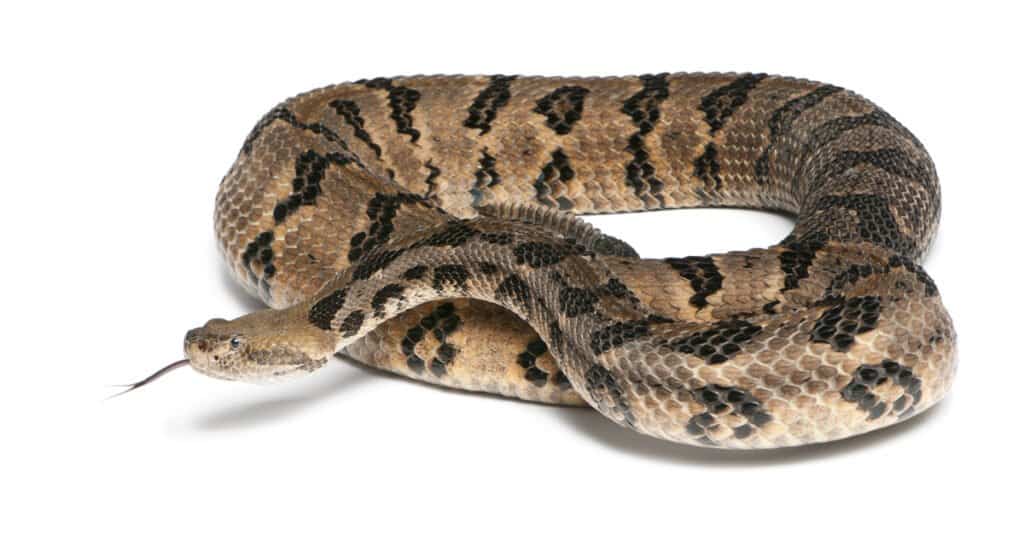
Timber rattlesnakes have a telltale rattle to help identify them.
©Eric Isselee/Shutterstock.com
Timber rattlesnakes can be found across Alabama. They are incredibly dangerous and have a similar pattern to copperheads. Like many rattlesnakes, they have a distinct rattle than can easily differentiate the two.
Cottonmouth
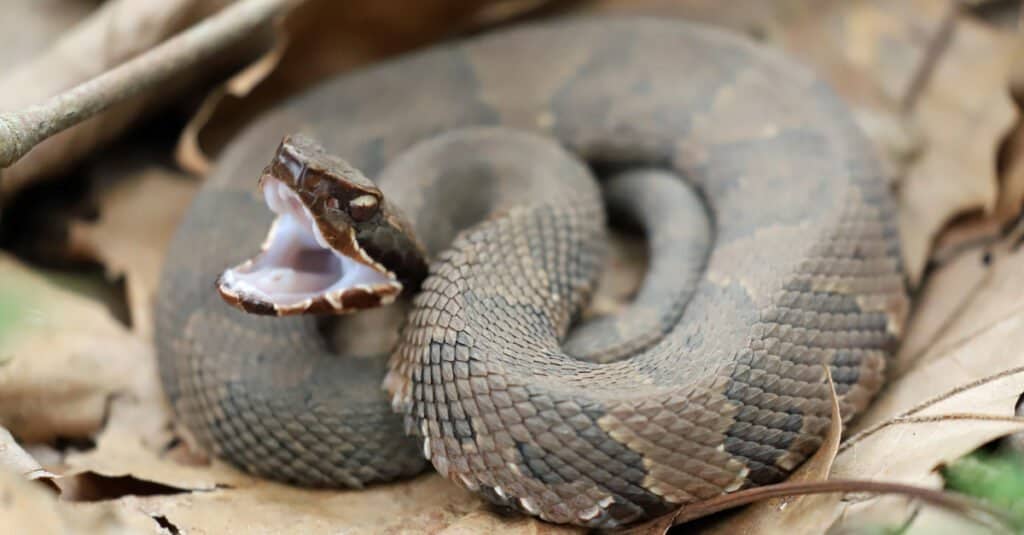
Cottonmouths have bright white mouths that are flashed as a defense mechanism.
©KF2017/Shutterstock.com
The cottonmouth is a venomous semi-aquatic snake that is large-bodied and gray. Some cottonmouths have faded brown bands that could be mistaken for a copperhead. The best way to tell the difference is that cottonmouths are usually larger, flash their white mouths as a defense mechanism, and don’t have an hourglass pattern.
Prairie kingsnake
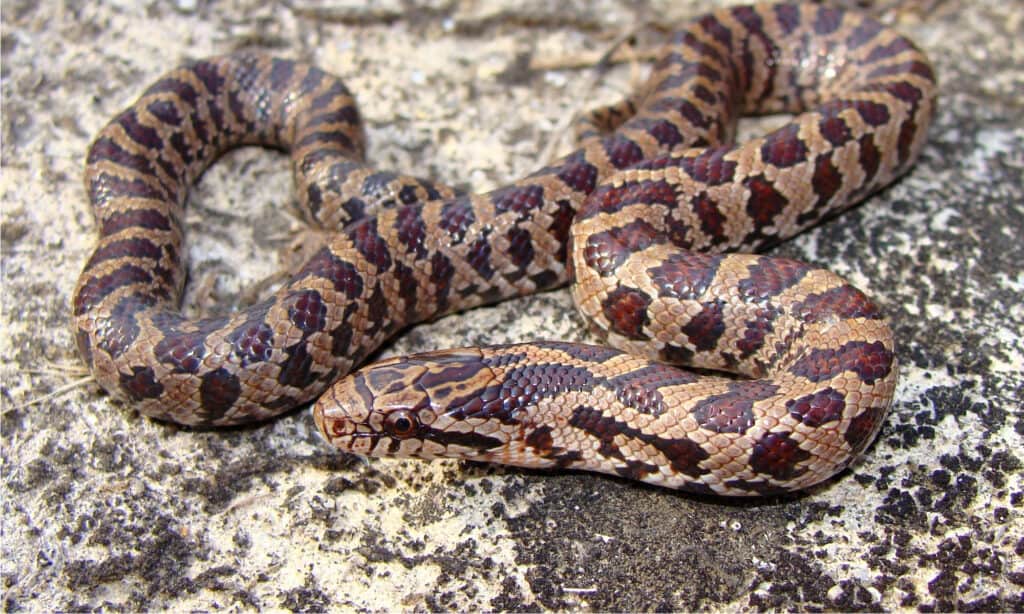
The prairie kingsnake has red patterns instead of brown ones.
©Matt Jeppson/Shutterstock.com
Prairie kingsnakes are light brown and have reddish-brown patterns. Their heads aren’t triangular like the copperhead, and their patterns aren’t hourglass-like. Additionally, they don’t have heat-sensing pits, and their eyes are black.
Gray ratsnake
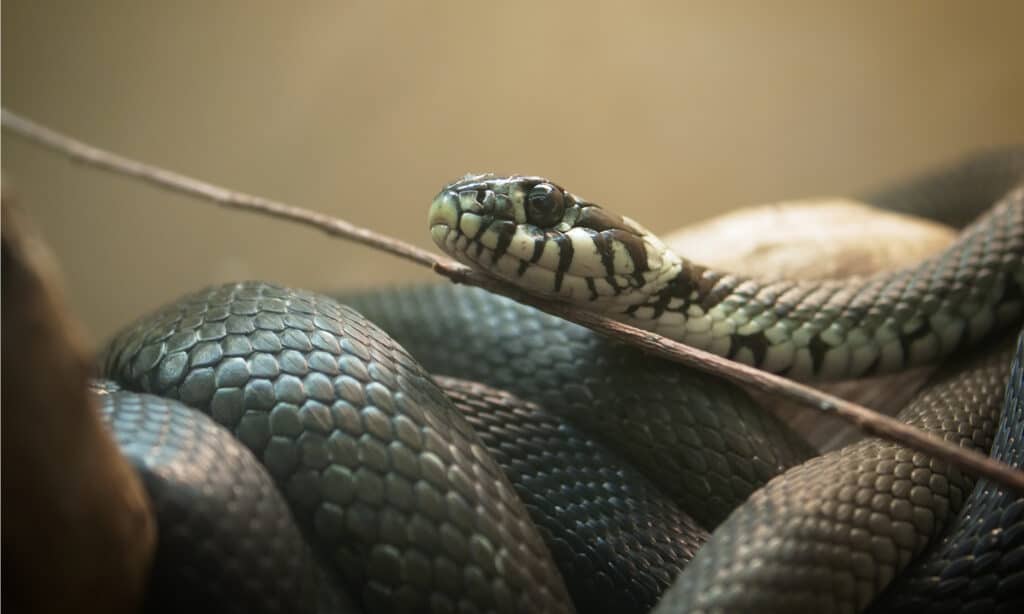
Gray ratsnakes are darker than copperheads and don’t have yellow eyes.
©dkHDvideo/Shutterstock.com
The gray ratsnake has similar colorations and patterns to the copperhead. The best way to tell the difference is through the head and eyes. Ratsnakes have black eyes and are not pit vipers, meaning they don’t have heat-sensing pits. Additionally, gray ratsnakes are darker in color than most copperheads.
Brown water snake
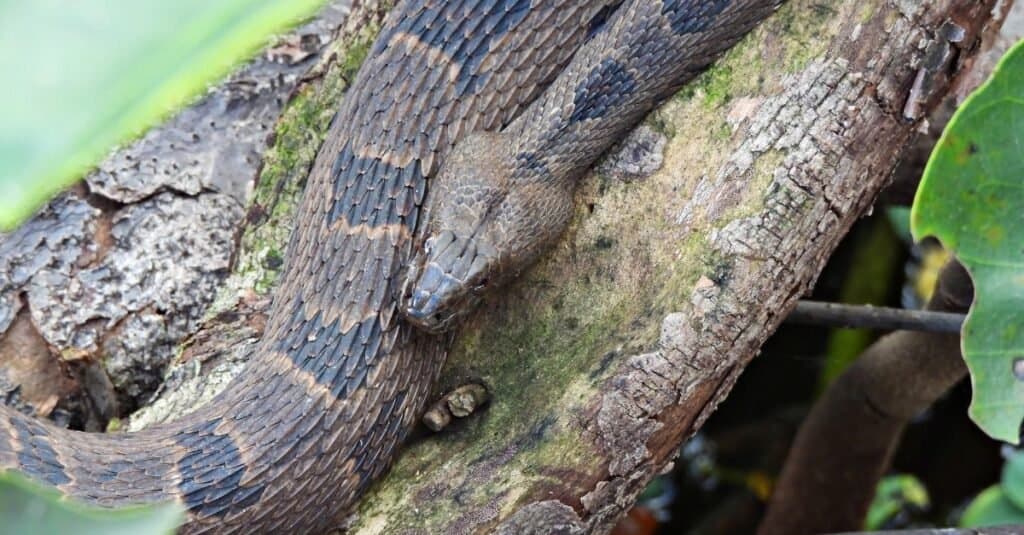
Brown watersnakes have a triangular head, with the eyes being set toward the top.
©iStock.com/passion4nature
The brown water snake is a nonvenomous snake that is more often confused for the cottonmouth than for the copperhead, but the similarity still stands. Watersnakes are aquatic snakes, but they have round heads, black eyes, and a faded pattern that is darker than the coppery tones of a copperhead.
The photo featured at the top of this post is © iStock.com/Mark Kostich
Discover the "Monster" Snake 5X Bigger than an Anaconda
Every day A-Z Animals sends out some of the most incredible facts in the world from our free newsletter. Want to discover the 10 most beautiful snakes in the world, a "snake island" where you're never more than 3 feet from danger, or a "monster" snake 5X larger than an anaconda? Then sign up right now and you'll start receiving our daily newsletter absolutely free.
Thank you for reading! Have some feedback for us? Contact the AZ Animals editorial team.






